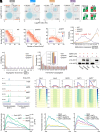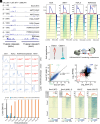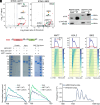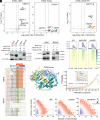Dual modes of DNA N6-methyladenine maintenance by distinct methyltransferase complexes
- PMID: 39813249
- PMCID: PMC11761967
- DOI: 10.1073/pnas.2413037121
Dual modes of DNA N6-methyladenine maintenance by distinct methyltransferase complexes
Abstract
Stable inheritance of DNA N6-methyladenine (6mA) is crucial for its biological functions in eukaryotes. Here, we identify two distinct methyltransferase (MTase) complexes, both sharing the catalytic subunit AMT1, but featuring AMT6 and AMT7 as their unique components, respectively. While the two complexes are jointly responsible for 6mA maintenance methylation, they exhibit distinct enzymology, DNA/chromatin affinity, genomic distribution, and knockout phenotypes. AMT7 complex, featuring high MTase activity and processivity, is connected to transcription-associated epigenetic marks, including H2A.Z and H3K4me3, and is required for the bulk of maintenance methylation. In contrast, AMT6 complex, with reduced activity and processivity, is recruited by PCNA to initiate maintenance methylation immediately after DNA replication. These two complexes coordinate in maintenance methylation. By integrating signals from both replication and transcription, this mechanism ensures the faithful and efficient transmission of 6mA as an epigenetic mark in eukaryotes.
Keywords: AMT1; DNA N6-methyladenine (6mA); PCNA; maintenance methylation; methyltransferase.
Conflict of interest statement
Competing interests statement:The authors declare no competing interest.
Figures







Similar articles
-
Identification and characterization of the de novo methyltransferases for eukaryotic N6-methyladenine (6mA).Sci Adv. 2025 May 16;11(20):eadq4623. doi: 10.1126/sciadv.adq4623. Epub 2025 May 14. Sci Adv. 2025. PMID: 40367178 Free PMC article.
-
Structural insight into the substrate binding of the AMT complex via an inhibitor-trapped state.Protein Sci. 2025 Sep;34(9):e70265. doi: 10.1002/pro.70265. Protein Sci. 2025. PMID: 40815297
-
Targeting N6-Methyladenine of Tubular Mitochondrial DNA Against Hypertensive CKD.Hypertension. 2025 Sep;82(9):1505-1519. doi: 10.1161/HYPERTENSIONAHA.124.24491. Epub 2025 Jul 18. Hypertension. 2025. PMID: 40677234 Free PMC article.
-
[Epigenetics' implication in autism spectrum disorders: A review].Encephale. 2017 Aug;43(4):374-381. doi: 10.1016/j.encep.2016.07.007. Epub 2016 Sep 28. Encephale. 2017. PMID: 27692350 French.
-
Stage-specific DNA methylation dynamics in mammalian heart development.Epigenomics. 2025 Apr;17(5):359-371. doi: 10.1080/17501911.2025.2467024. Epub 2025 Feb 21. Epigenomics. 2025. PMID: 39980349 Review.
Cited by
-
Bromodomain-containing proteins in the unicellular eukaryote Tetrahymena thermophila.Zool Res. 2025 May 18;46(3):538-550. doi: 10.24272/j.issn.2095-8137.2025.011. Zool Res. 2025. PMID: 40259734 Free PMC article. Review.
-
Introducing the "other" type of DNA methylation.Sci Adv. 2025 May 16;11(20):eadx6879. doi: 10.1126/sciadv.adx6879. Epub 2025 May 14. Sci Adv. 2025. PMID: 40367161 Free PMC article. Review.
-
SMAC: identifying DNA N6-methyladenine (6mA) at the single-molecule level using SMRT CCS data.Brief Bioinform. 2025 Mar 4;26(2):bbaf153. doi: 10.1093/bib/bbaf153. Brief Bioinform. 2025. PMID: 40205850 Free PMC article.
-
Inferring gene-pathway associations from consolidated transcriptome datasets: an interactive gene network explorer for Tetrahymena thermophila.NAR Genom Bioinform. 2025 May 27;7(2):lqaf067. doi: 10.1093/nargab/lqaf067. eCollection 2025 Jun. NAR Genom Bioinform. 2025. PMID: 40432793 Free PMC article.
-
Identification and characterization of the de novo methyltransferases for eukaryotic N6-methyladenine (6mA).Sci Adv. 2025 May 16;11(20):eadq4623. doi: 10.1126/sciadv.adq4623. Epub 2025 May 14. Sci Adv. 2025. PMID: 40367178 Free PMC article.
References
-
- Sanchez-Romero M. A., Cota I., Casadesus J., DNA methylation in bacteria: From the methyl group to the methylome. Curr. Opin. Microbiol. 25, 9–16 (2015). - PubMed
-
- Bochtler M., Fernandes H., DNA adenine methylation in eukaryotes: Enzymatic mark or a form of DNA damage? Bioessays 43, e2000243 (2021). - PubMed
-
- Mondo S. J., et al. , Widespread adenine N6-methylation of active genes in fungi. Nat. Genet. 49, 964–968 (2017). - PubMed
MeSH terms
Substances
Grants and funding
- 32125006 32070437/MOST | National Natural Science Foundation of China (NSFC)
- 32200399/MOST | National Natural Science Foundation of China (NSFC)
- ZR2021QC046/Natural Science Foundation of Shandong Province
- ZR2024MC112/Natural Science Foundation of Shandong Province
- 202441014/the Fundamental Research Funds for the Central Universities
LinkOut - more resources
Full Text Sources
Medical
Miscellaneous

